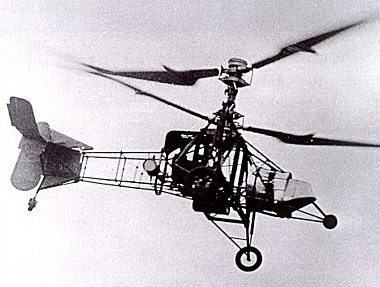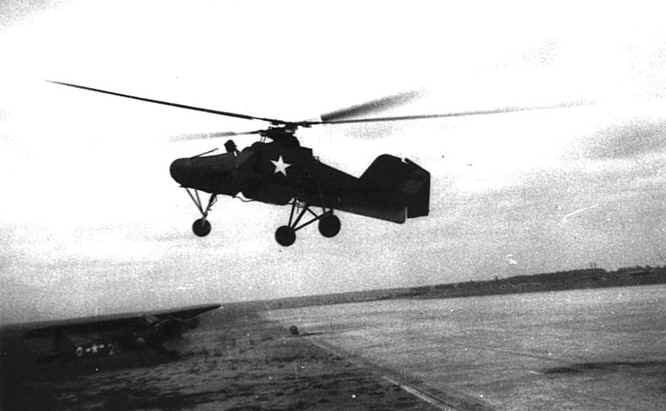The dream of the helicopter
The idea of the helicopter is as old as the dream of being able to fly. When the first aircraft appeared, it was a giant leap towards the human dream of flying, but aircraft still had some imitations, that very soon became clearly apparent.
Even the lightest of aircraft required a runway or at least a flat area in order to take off and land. The larger and heavier aircraft became, the longer and better built the airfield needed to be. The greatest competitor to aircraft during the first third of the twentieth century, the airship, commonly called the”Zeppelin”, demanded enormous hangars. However they could fly much further and did not need such developed infrastructure as prepared runways or airfields, etc. Smaller airship versions could also take off and land on small fields.
What many wished for was a machine that could fly straight up off the ground and straight down again and easily land on small open areas. The first person to sketch such a hypothetical “airscrew” was Leonardo da Vinci at the start of the 16th Century, but from the outset he realised that what was needed to turn theory into practice was a power source, that did not exist at the time. This was a recurring theme for those who studied to possibility of human flight throughout the following centuries. It was only the advent of the internal combustion engine that a real possibility arose.
In respect of the helicopter there was also the problem of how to counteract the turning moment (torque) of the vertical propeller (now called the rotor) to prevent the entire vehicle from spinning round. This was a problem that appeared to be insoluble.
At the beginning of the 20th Century there were several people trying to invent the helicopter, inspired by the way that aircraft had become reality. But most gave up, even the young Igor Sikorsky, who however would return to the helicopter later in life.
Juan de la Cierva and the autogiro
The first person to succeed in solving the torque problem of the rotor was the Spaniard Juan de la Cierva, who in 1920 realised that the helicopter’s rotor really functioned the same as an aircraft’s wing. As it moved forward through the air it generated lift, even if it turned due to the machine’s forward movement. This phenomenon was called “autorotation” and is today a helicopter’s most important lifeline if its engine stops while airborne. As long as the rotor can spin unobstructed, the helicopter can be landed safely.
La Cierva’s machine had a freely rotating rotor instead of a pair of wings. The power to move forwards came from an engine that drove a propeller in the nose just like a normal aircraft. As the forward speed increased, the rotor above turned more quickly and thereby generated a lifting force. Since there was no engine to drive the rotor round, no torque was generated. The machine, called an autogiro, could not take off vertically, but only needed a very short distance to get off the ground. After making improvements to provide more control of the angle of the rotor blades and their slope, La Cierva could by 1933 present a design that could make a so-called “jump-start” and required even less distance to take off. La Cierva and his autogiros eventually lost ground to the later real fully functioning helicopters, but his contribution to their development was invaluable. Also, even though the autogiro did not exert so much influence, the concept was never entirely abandoned as despite only partly having the full advantage of the helicopter, it is simpler and cheaper. Autogiros today have begun to increase in popularity among sport pilots, providing a simpler and cheaper alternative to aircraft and helicopters.
The first real helicopters
The one person who is popularly recognised as the inventor of the modern helicopter is the previously mentioned Russian-American Igor Sikorsky. This however is not entirely true. It was in fact in France, and later in Germany that the first practically useful helicopters were constructed. The French engineer Louis Breguet designed the experimental helicopter known as the Breguet-Dorand Gyroplane Laboratoire, that was the first helicopter that could be flown and controlled while in the air. It first flew in 1935.

Breguet’s machine in the air in 1935.
The German designer Heinrich Focke started off with the autogiro, and in 1937 his design, the Fa-61 broke all previous records. This was a true helicopter with an engine that drove two rotors positioned side by side. Focke then made a larger version of the Fa-61 for the German armed forces, the Fa-223 Drache (Dragon), that could fly up to and altitude of more than 7,000 metres (23,000 feet).

A captured Fa-223 being tested in the USA after the war. Photograph: US Air Force
Nor was Focke alone, as there was another German designer, Anton Flettner, who at the beginning of the 1930s began to study helicopter principles. He started off on the basis of the autogiro, and with support from the German Navy he could develop the Fl-265. In 1940 he brought out the further developed FL-282 Kolibri (Hummingbird). According to some writers, the Fl-282 was also the world’s first production helicopter, although only in a limited number. Others maintain that it was Focke’s Fa-223 that was first. 20 or so of each of these types were manufactured.

The American forces also captured an Fl-282 that is seen here during a test flight. Photograph: US Air Force
The identifying feature of the German helicopters was their use of use of two rotors to solve the torque and control problems. Focke used a design with two separate side-by side rotors, while Flettner’s machine had two overlapping rotors that were synchronised so that they did not strike each other.
Modifications in the form of a two-seat variant made it possible to use the helicopter for reconnaissance and artillery spotting. This meant that Germany could, at the end of the Second World War establish the first operational helicopter squadron with three FI-282s and three of Focke’s Fa-223 Drache. Their task was artillery observation for German guns. Already in 1941 the German Navy had begun testing the Fl-282 as a ship-based reconnaissance machine aboard the cruiser Köln (Cologne).
When the allied armies pushed into German territory in 1945, those helicopters that were still working fell into the victors’ hands and were keenly studied by both Eastern and Western powers. The German helicopters were technically complex machines, which meant that they could not be produced in large quantities.
Sikorsky and the advent of the classic helicopter
Igor Sikorsky had followed the developments in Germany during the 1930s closely, and decided to resume attempts to design a helicopter himself. Sikorsky’s contribution was that instead of having the German designers’ method of two counter-rotating rotors he chose to develop a machine with one large rotor above and a small tail rotor. The idea was that the tail rotor would counter the torque effect. Sikorsky obtained a patent for his design in the USA in 1935, but it was not until 1939 that his VS-300 first took to the air. However, Sikorsky had major problems in controlling his machine.

The VS-300 in the air with a well-dressed Sikorsky at the controls. Photograph: US Air Force
In 1940 Sikorsky was tasked by the US Army Air Corps, which would later become the US Air Force, to bring out an experimental helicopter called the XR-4. This allowed Sikorsky to begin to solve the final design problems, and the result formed the basis for the most common type of helicopter that is flying today. Namely a machine with one large main rotor and a long tail tipped by a smaller rotor to counteract torque and permit the helicopter to turn as required.
Since, despite the war, the USA was a safe place, Sikorsky could begin to catch up with the German designers’ lead, since they had to fight for resources within the German war industry, and also had to overcome the effects of allied bombing raids on German factories. By 1942 Sikorsky could present an improved version of the XR-4, and this became the basis for the YR-4, that was ordered by the American forces. By the end of the war in 1945, 131 YR-4s had been manufactured. Even though helicopters were not widely used during the war, the first SAR (Search and Rescue) mission using a helicopter had been carried out in the Burmese jungle (now called Myanmar). The military were very pleased with the result.

An R-4 belonging to the US Coast Guard in 1944.
So even though Igor Sikorsky was not the first to produce a and operating and not even a series production helicopter, it was his basic design that made an enormous breakthrough. The German helicopters and their technical solutions began to be forgotten. The future belonged to Sikorsky.
